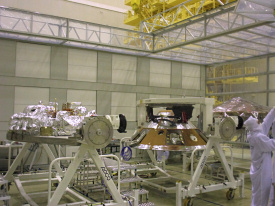Analysing the atmosphere with AMELIA: An interview with Francesca Ferri, Principal Investigator of AMELIA
 |
| Francesca Ferri, Principal Investigator (PI) for AMELIA. Credit: F. Ferri |
The first mission of ESA's ExoMars programme, which is scheduled to arrive at Mars in October 2016, consists of the Trace Gas Orbiter plus Schiaparelli, an entry, descent and landing demonstrator module.
The scientific payload on Schiaparelli includes the AMELIA (Atmospheric Mars Entry and Landing Investigations and Analysis) experiment.
The Principal Investigator (PI) for AMELIA is Francesca Ferri from the Università degli Studi di Padova in Italy.
We asked Francesca to tell us more about the experiment that she and her colleagues have developed.
What is AMELIA?
AMELIA is an experiment to study some of the major properties of the Martian atmosphere, such as density, pressure and temperature, from an altitude of about 130 km all the way down to the surface. It will exploit the engineering measurements performed by Schiaparelli's sensors to conduct scientific investigations of Mars' atmosphere and surface.
What are the science objectives for AMELIA?
The ExoMars entry, descent and landing offers a rare opportunity to perform in situ investigations of the Martian environment over a wide altitude range.
The data recorded by Schiaparelli during the entry and descent will be used to characterise the structure of the atmosphere along the probe's trajectory, something that has been done only six times before by Mars entry probes: Viking 1 and 2, Mars Pathfinder, Mars Exploration Rovers (Spirit and Opportunity), and Phoenix. Prior to this, the first in situ measurements of the structure of Mars' atmosphere were obtained with the Mars 6 mission, launched by the USSR in 1973.
With AMELIA, we will investigate the dynamics and the horizontal structure of the atmosphere, by measuring the temperature profile and wind characteristics.
This study will allow us to determine the vertical motion of atmospheric gravity waves and tides, so that we can learn more about vertical coupling between the lower and upper atmosphere. This is of particular relevance for understanding the climate of Mars and it provides essential inputs for the Mars General Circulation Models. The data will allow us to study an altitude range that is not covered by remote sensing observations from orbiters or by instruments on the surface.
We will also be able to determine changes in the abundances of aerosols – fine dust, and condensates such as ice particles and clouds.
Results from AMELIA will complement the measurements of the environmental conditions at the surface at Mars that are obtained with DREAMS for investigating the meteorology of Mars.
Apart from reconstructing the atmospheric vertical profile, we'll attempt also to characterise the nature of the landing site, by inferring properties of the soil such as the texture, context and geomorphology from the measurements taken at the touch-down, and by combining this mapping of the landing site with the images taken with the descent camera DECA.
How will AMELIA operate?
 |
| Schiaparelli with front shield and back cover of the aeroshell removed. Credit: ESA - A. Haldemann |
We will receive data from the engineering instrumentation on Schiaparelli that performs measurements during the entry, descent and landing phases.
Within the AMELIA team, different approaches, algorithms and methods will be used to simulate and reconstruct Schiaparelli's trajectory and attitude during the entry and descent phases so that we can retrieve the most accurate atmospheric profile.
A near real-time reconstruction of the trajectory will be done using the radio link between Schiaparelli and the receiver on the orbiter, and by detection of the carrier signal by radio telescopes and ground-station antennas on Earth.
Vertical profiles of density, pressure and temperature will be derived directly from probe deceleration measurements and from hypersonic dynamic pressure data recorded during the high-speed entry by sensors located on Schiaparelli's front shield.
The dynamical behaviour of Schiaparelli while it is descending beneath the parachute will be modelled, simulated and reconstructed, using data from the onboard inertial measurement unit, the radio link, radar, imaging, and other data.
The wind profile along the entry probe's path will be retrieved by using the Doppler shift in the radio link between Schiaparelli and a radio receiver, and by modelling the sideways movement of Schiaparelli when it descends beneath its parachute.
How did AMELIA come about?
The entry, descent and landing system of an atmospheric entry probe or lander requires measurements to trigger the events of the descent sequence. These measurements, besides being used to guarantee a safe landing, can provide essential information for the study of a planet's atmosphere.
Following the success at Titan, in 2005, of the Huygens Atmospheric Structure Instrument during the Cassini-Huygens mission, we proposed a similar experiment for the ExoMars project.
Entry, descent and landing science was endorsed by ESA in 2008 and AMELIA was selected as an experiment in 2011.
What is the current status of the experiment?
Within the AMELIA team, we have developed various tools for the reconstruction of the probe's trajectory and attitude and for the retrieval of the atmospheric profile. We are working on the simulations and the fine-tuning of the models of probe dynamics and the Martian atmosphere.
How have you been preparing to interpret data from AMELIA?
Analysis of the previous observations at the ExoMars 2016 landing site and atmospheric modelling are helping us to predict the possible weather conditions that Schiaparelli will face during its descent and the scientific interpretation of future measurements.
We are running simulations using different data and methods to assess the performance of our reconstructions on the basis of the data that we expect to get from Schiaparelli.
Who are the AMELIA team?
The team is led by me and three Co-Principal Investigators: François Forget from France, Stephen R. Lewis from the UK, and Özgür Karatekin from Belgium. The team includes scientists from Italy, France, UK, Belgium, Finland, Germany and the USA, and they cover a broad range of expertise.


